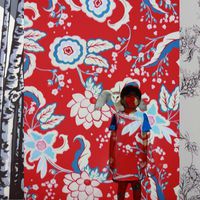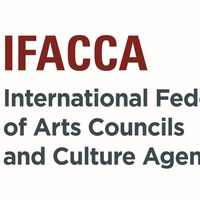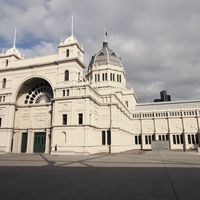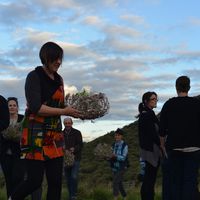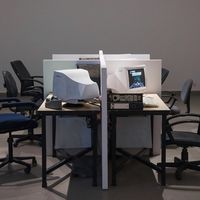Learning from experience: Supporting diverse voices in the Australian arts sector

How are the arts adapting to the #NewNormal"? One year into the global pandemic, this series presents experiences and stories of #resilience, #adaptation, and success from the arts sector to the Covid-19 pandemic, with particular focus on arts & disabilities, artists residencies and arts funding.
Can emergency funding to keep artists and arts organisations afloat transition to a re-imagined model for a more resilient, equitable and thriving future? At the very least increased diversity needs to be at the heart of the ‘new-normal’.
Although Australia has been able to control their Covid-19 numbers, parts of the country have been heavily impacted by lockdown. As in so many parts of the world, the lockdown disproportionately affected arts workers, already in precarious work conditions. Early predictions from the Australian Bureau of Statistics estimated that at least 53% of the arts sector ceased functioning by April 2020 and the Grattan Institute have estimated that up to 75% of those in the creative and performing arts could lose their jobs.
The pandemic has taken a great toll on those working in the arts as they struggle with uncertainty and loss of hope. It will take time to understand the ongoing impact and as one artist explains, ‘I expect to see the damage in the next year as some things return to normal, while other parts of life will be damaged forever’.
Federal funding schemes
In spite of the arts’ 2016-17 contribution of A$111.7 billion to Australia’s economy (or about 6.4% of GDP), in response to the Covid-19 lockdowns there has been less support for the creative industries than other sectors. Taking the arts for granted is not new. In 2019 the federal government incorporated the arts portfolio into the Department of Infrastructure, Transport, Regional Development and Communications, and the Australia Council, the key arts funding body, has had several budget reductions. This resulted in the Australia Council, in 2016, ceasing funding 65 arts companies and organisations and reducing to up to 70% the grants for individuals. This was followed in 2019 with a further reduction in long term funding for many organisations.
In response to Covid-19-induced hardship, the federal government was slow in responding to the needs of the creative sector, while the Australia Council’s initial 2020 Resilience Fund of AUD 5 million was sourced from other grant schemes. The funding support was increased in the 2020-21 federal budget by 13.9% (which will then decrease by 8.9% by 2023-24), which ‘includes around $700 million of additional support to the sector in response to the pandemic’. Although, it should be noted that this funding includes AUD 90 million in loans assistance and AUD 400 million for the Location Incentive scheme to attract large international film and television productions to Australia over a 7-year period. The latter might be welcome for job creation, but it isn’t directed at Australian productions. Additionally, the recipients for the AUD 75 million COVID-19 arts relief package will be selected by department officials and the projects must be ‘an efficient, effective, economical and ethical use of public resources’, they must ‘be popular with Australian audiences’ and they need to contribute ‘to government objectives’. This involvement of the Department puts at risk the arms-length approach to arts funding, and is reminiscent of previous intervention from the Department which resulted in a reduction of the Australia Council funding.
Other general funding schemes to support employees and small businesses through Covid-19 were available to artists and arts organisations, such as fortnightly payments for those who could prove their income had fallen by more than 30%. However, it has been argued that the eligibility becomes complicated for arts workers on short term contracts, those who worked casually or those with a combination of jobs.
The case of Victoria
Victoria was one of the states that was the most severely impacted by the second wave of Covid-19, leading to a strict lockdown between 7 July and 28 October 2020. Although it was successful in battling the pandemic, it had a high cost for the arts sector.
There have been a number of initiatives throughout Victoria that have stepped in to support artists and arts organisations. The Victorian Government announced a total of AUD 107.2 million to help the state’s creative sector and Creative Victoria, the state arts funding body, had a number of programmes to sustain creative workers as well as those that specifically targeted the struggling music industry.
Other initiatives include the Creative Workers in Schools programme to support 150 creative workers to undertake a six-month paid residency in Victorian government schools in 2021 or the VicHealth Reimagining Health Grants for creatives, local councils and community organisations who help young people and Victorians experiencing disadvantage.
Local councils also stepped in, offering small business, community and arts grants, ranging from AUD 2,000 for individual grants from some local councils to the City of Melbourne’s pool of AUD 2 million for artists and creatives.
Supporting diverse voices
Multicultural Arts Victoria (MAV) is an organisation dedicated to supporting diverse artists and along with their own programming they also offer a consultation service to connect diverse artists with events. In response to the impact of Covid-19 and the lockdown, MAV implemented the Shelter commissions programme, which engaged diverse artists and artists of colour to produce new works that reimagined relationships to home. The first round supported 45 artists and presented their work online.

Te Pae o Maumahara (The Site of Memories) by Tāne Te Manu McRoberts, which he began weaving when the COVID-19 isolation started, in memory of a highly respected elder in the Māori community who passed away during this time. The project was supported by the MAV Shelter programme.
As MAV CEO Veronica Pardo explains, ‘Through Shelter and the perspectives of diverse artists, we will be challenged to broaden our understanding of the human condition. This is the essence of cultural leadership’. This programme, and MAV’s position in the arts sector, plays a vital role in supporting diverse voices. The lack of diversity in the arts sector in Australia is being increasingly criticised and a 2019 report funded by UNESCO and led by Diversity Arts Australia found that this was also a problem in arts leadership. The report found that cultural and linguistically diverse Australians are under-represented in leadership positions in every art practice of Australia’s significant arts, screen and creative companies and organisations.
Covid-19 and the responses to it have demonstrated the need for listening to diverse voices. One concerning example is the case in Melbourne of the lockdown of 9 public housing estates in July. During this police-enforced lockdown, 3,000 people were not allowed to leave their 20-story apartment buildings for any reason, not even for food. The lockdown was poorly communicated, causing confusion and panic in the residents, many of whom were migrants from non-English-speaking backgrounds. Residents were given no warning, they had no time to stock up on necessary supplies, they couldn’t use the shared laundry facilities and there were claims the supplies arrived late and were insufficient. In addition, information was initially only given in English, which was then translated by community members. In some cases, residents who were away from home when the lockdown began were not able to return for two weeks. Since the lockdown of the towers was different to the rest of the city, in spite of the fact that infection rates were not dissimilar to other parts of the city, there were many who argued it was discriminatory. As one resident explained to the national broadcaster, ‘We are Melburnian, we are Victorian, we are Australian, and yet we've been treated differently’. There were many who called for better communication and consultation with communities.
The challenges faced in the implementation of this public health response highlight the importance of listening to diverse voices and to the lived experiences of different communities, which makes the MAV commissioning programme so interesting. For the second round of Shelter commissions MAV focused on artists who live through this lockdown. MAV has announced the funding of 15 artists from the affected public housing estates, supporting film, visual arts, poetry, spoken word and music. The MAV Shelter programme is a chance move beyond the headlines and understand the perspectives from a wide range of residents.
Re-imagining funding models
As a first response to Covid-19 most funding has focused on small, quick response grants (to bridge the income gap for artists) as well as maintaining jobs and business. In some cases, the funding programmes have supported upskilling and the development of online capacities, to support artists and arts organisation as they transition from live to online delivery models. But the financial viability of these new models has yet to be tested and there are signs that things can’t return to a pre-Covid-19 normal.
In response to the unprecedented challenges faced by the creative sector, the Australia Council announced the Re-imagine: sector recovery initiatives fund, which supports ‘Australia’s cultural and creative industries to re-imagine practice and operations and provide the needed resources and time to test ideas and models for a more resilient, equitable and thriving future’. The two streams are ‘cultural and creative solutions’ (to re-imagine practice and operations post-Covid-19) and ‘industry collaborations’ (for collaborations across and beyond the cultural and creative industries).
It is too early to say which directions the funding will go in, but it is clear that diverse voices need to be part of the conversation. This is necessary not only for the creative sector itself, but to address the lack of connection and communication with diverse communities displayed during this public health crisis. Arts is a way to bridge this gap and better understand distinct experiences and perspectives.
Claire Rosslyn Wilson is a freelance cultural writer, researcher and editor. She has particular interests in cultural diversity, experiences of place and creative expression for social change and has worked in Thailand, Singapore, Spain and Australia. She co-wrote ‘Freelancing in the Creative Industries’ (Oxford University Press, 2015) and is a co-editor of the journal Coolabah, of the Transnational and Australian Studies Centre in the University of Barcelona.
Similar content
deadline
11 May 2022
posted on
28 Mar 2022
01 Aug 2017
04 Sep 2018
posted on
21 Sep 2020
14 Jan 2021

